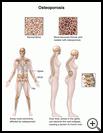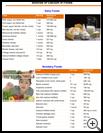
Osteoporosis in Women
________________________________________________________________________
KEY POINTS
- Osteoporosis is a disease that thins and weakens bones to the point where they may break easily causing fractures in the hip, spine, or wrist.
- Treatment can slow down the loss of bone and may include changes in your diet and exercise program. Your healthcare provider may prescribe medicine to slow the loss of bone and reduce the risk of fractures.
- Eat a healthy diet, and ask your healthcare provider if there are any limits on your exercise. If you smoke, try to quit. If you drink alcohol, ask your healthcare provider how much is safe for you to drink.
________________________________________________________________________
What is osteoporosis?
Osteoporosis is a disease that thins and weakens bones to the point where they may break easily. This disease most often causes fractures of the bones in the hip, spine, or wrist, but any bone can be affected.
What is the cause?
Your body is always making new bone to replace old bone. When you have osteoporosis, your bone breaks down and doesn’t replace itself completely, resulting in weak bones.
Osteoporosis often starts to develop in women around the time of menopause, usually between the ages of 45 and 55. After menopause, a woman’s body makes much less estrogen. Estrogen is a female hormone that helps bones stay strong.
Osteoporosis is most common in white and Asian women, especially slim women, but anyone can have it. It is more common in women than in men because women have less bone mass and lose bone at a younger age and faster than men do.
Things that increase your risk of osteoporosis include:
- Lifestyle habits such as:
- Smoking
- Having more than 1 drink of alcohol a day
- Too little calcium in the diet
- Not enough exercise to help bones stay strong, like walking, dancing, or lifting weights
- Family history of osteoporosis
- Surgical removal of the ovaries, which lowers estrogen levels
- Long-term use of some medicines, such as steroids used to treat medical problems such as asthma or arthritis, thyroid medicines, some anti-seizure medicines, aluminum-containing antacids, and some cancer treatments
- Diseases, such as diabetes, hyperthyroidism, and heart failure
- Having osteopenia, which is low bone density
- Less commonly, too much exercise such as training for and running marathons, which lowers estrogen levels
- Long periods of bed rest during serious illness
- Eating disorders, such as anorexia nervosa, or too much dieting
What are the symptoms?
Usually, you don’t have any symptoms until a bone breaks. Broken bones are the most common problem for people with osteoporosis. Often the hip, arm, or wrist breaks, usually as the result of a fall or serious bump.
The bones of the spine called vertebrae may also break. They can break from injury or just from lifting something heavy or suddenly bending. Fractures in the spine can cause a loss of height, back pain, and a stooping posture.
How is it diagnosed?
Your healthcare provider will ask about your symptoms and medical history and examine you. Tests may include:
- A bone mineral density test, such as a DEXA scan, is a special X-ray exam of the spine, hip, or wrist. A DEXA scan is recommended for all women age 65 and older. If you have a high risk for osteoporosis, your healthcare provider can advise you about having a DEXA scan at an earlier age.
- An ultrasound, which uses sound waves to show pictures of the bones
How is it treated?
Treatment can slow down the loss of bone and rebuild some bone. It does not restore bone strength all the way back to normal. Treatment may include:
- Weight-bearing exercise. Daily weight-bearing exercise, such as walking or stair climbing, helps keep your bones strong and strengthens your muscles.
- Calcium in the diet. Calcium helps your bones stay healthy. Adult women 19 to 50 years old should have 1000 milligrams (mg) of calcium a day. Women over 50 need 1200 mg a day. Calcium is found naturally in foods such as milk, yogurt, and cheese. It can also be taken as a supplement if your healthcare provider recommends it.
- Good levels of vitamin D in the blood. If you have low blood levels of vitamin D, you may need to take supplements. Vitamin D helps your body absorb and use calcium. The current US recommendations for vitamin D are 600 international units (IU) a day if you are 70 or younger and 800 IU a day if you over 70.
- Medicine to slow bone loss and help reduce fractures. Medicine may be prescribed if your bone loss does not get better with other treatments. It may also be prescribed if you have had a broken bone because of osteoporosis.
How can I take care of myself and help prevent osteoporosis?
Follow the full course of treatment prescribed by your healthcare provider. In addition:
- Eat a healthy diet. Foods such as low-fat milk and dairy products, green leafy vegetables, citrus fruits, sardines, and shellfish can help you get calcium. Ask your healthcare provider if you should take a daily calcium or vitamin D supplement.
- Get regular weight-bearing exercise. Walking is especially good. Strengthening your muscles as well as your bones can help prevent falls. Ask your healthcare provider if there are any limits on your exercise.
- If you smoke, try to quit. Talk to your healthcare provider about ways to quit smoking.
- If you want to drink alcohol, ask your healthcare provider how much is safe for you to drink.
- Avoid antacids that contain aluminum, such as Amphojel, Gaviscon, or Mylanta.
- Try to make your home safe from accidents to prevent falls and injury. If you have had problems with falling, be sure to let your healthcare provider know. You may need physical therapy to improve your balance and walking. If you are unsteady when walking, use a cane or walker.
- Wear sturdy shoes with soles that grip, especially in the winter or when it rains.
- Ask your healthcare provider:
- How and when you will get your test results
- If there are activities you should avoid and when you can return to your normal activities
- What symptoms or problems you should watch for and what to do if you have them
- Make sure you know when you should come back for a checkup. Keep all appointments for provider visits or tests.
- You can get more information from:
National Osteoporosis Foundation
800-223-9994
https://www.nof.org


